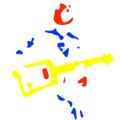The study of rhythm has to start with the beat.
Tap your foot along with any old tune and you've found the beat. It hums along at a constant speed that we refer to as the tempo and is often measured as the amount of beats in a minute (bpm). The clock on the wall has a tempo of 60 bpm. Beat and tempo give your music a predictability that the listener can latch on to so when you're playing your own song you'll want it to be at a constant tempo and provide a pulse that all of the rhythms and melodies in your tune can sit in.
Play the audio file here and tap along with the beat with your foot on the floor and your finger on the table. While you're at it count each beat 1,2,3,4,1,2,3,4,1,2,3,4,.....
Notice that the same pattern repeats every 4 counts or beats. Most of the songs you'll play here use the same 4 beat pulse to underscore their rhythmic patterns.
What do you notice every time you count 2 and 4? This is called the backbeat (remember the Chuck Berry song Rock and Roll Music, it's got a backbeat you can't lose it). This emphasis, also called an accent, of the backbeat is an important rhythmic device.
Take Home
Can you tap your foot to the beat in the audio file on this page? On other music as well?
